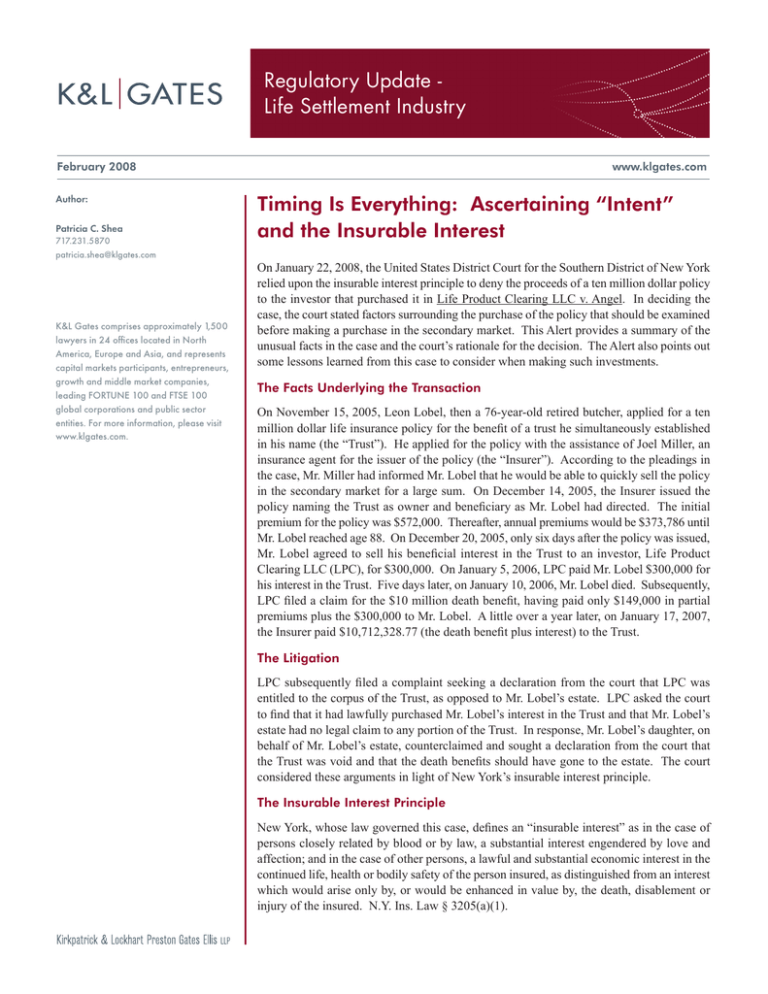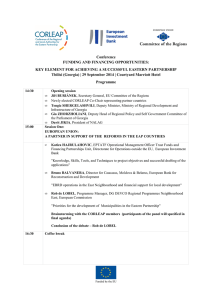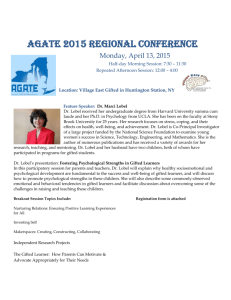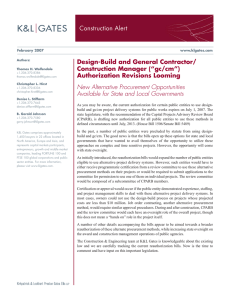
Regulatory Update Life Settlement Industry
February 2008
Author:
Patricia C. Shea
717.231.5870
patricia.shea@klgates.com
K&L Gates comprises approximately 1,500
lawyers in 24 offices located in North
America, Europe and Asia, and represents
capital markets participants, entrepreneurs,
growth and middle market companies,
leading FORTUNE 100 and FTSE 100
global corporations and public sector
entities. For more information, please visit
www.klgates.com.
www.klgates.com
Timing Is Everything: Ascertaining “Intent”
and the Insurable Interest
On January 22, 2008, the United States District Court for the Southern District of New York
relied upon the insurable interest principle to deny the proceeds of a ten million dollar policy
to the investor that purchased it in Life Product Clearing LLC v. Angel. In deciding the
case, the court stated factors surrounding the purchase of the policy that should be examined
before making a purchase in the secondary market. This Alert provides a summary of the
unusual facts in the case and the court’s rationale for the decision. The Alert also points out
some lessons learned from this case to consider when making such investments.
The Facts Underlying the Transaction
On November 15, 2005, Leon Lobel, then a 76-year-old retired butcher, applied for a ten
million dollar life insurance policy for the benefit of a trust he simultaneously established
in his name (the “Trust”). He applied for the policy with the assistance of Joel Miller, an
insurance agent for the issuer of the policy (the “Insurer”). According to the pleadings in
the case, Mr. Miller had informed Mr. Lobel that he would be able to quickly sell the policy
in the secondary market for a large sum. On December 14, 2005, the Insurer issued the
policy naming the Trust as owner and beneficiary as Mr. Lobel had directed. The initial
premium for the policy was $572,000. Thereafter, annual premiums would be $373,786 until
Mr. Lobel reached age 88. On December 20, 2005, only six days after the policy was issued,
Mr. Lobel agreed to sell his beneficial interest in the Trust to an investor, Life Product
Clearing LLC (LPC), for $300,000. On January 5, 2006, LPC paid Mr. Lobel $300,000 for
his interest in the Trust. Five days later, on January 10, 2006, Mr. Lobel died. Subsequently,
LPC filed a claim for the $10 million death benefit, having paid only $149,000 in partial
premiums plus the $300,000 to Mr. Lobel. A little over a year later, on January 17, 2007,
the Insurer paid $10,712,328.77 (the death benefit plus interest) to the Trust.
The Litigation
LPC subsequently filed a complaint seeking a declaration from the court that LPC was
entitled to the corpus of the Trust, as opposed to Mr. Lobel’s estate. LPC asked the court
to find that it had lawfully purchased Mr. Lobel’s interest in the Trust and that Mr. Lobel’s
estate had no legal claim to any portion of the Trust. In response, Mr. Lobel’s daughter, on
behalf of Mr. Lobel’s estate, counterclaimed and sought a declaration from the court that
the Trust was void and that the death benefits should have gone to the estate. The court
considered these arguments in light of New York’s insurable interest principle.
The Insurable Interest Principle
New York, whose law governed this case, defines an “insurable interest” as in the case of
persons closely related by blood or by law, a substantial interest engendered by love and
affection; and in the case of other persons, a lawful and substantial economic interest in the
continued life, health or bodily safety of the person insured, as distinguished from an interest
which would arise only by, or would be enhanced in value by, the death, disablement or
injury of the insured. N.Y. Ins. Law § 3205(a)(1).
Regulatory Update - Life Settlement Industry
New York law prohibits obtaining “directly or by
assignment or otherwise any contract of insurance
upon the person of another unless the benefits under
such contract are payable to the person insured or his
personal representatives, or to a person having, at the
time when such contract is made, an insurable interest
in the person insured.” N.Y. Ins. Law § 3205(b)(2)
(emphasis added). So, an insurable interest must
exist at the time the insurance policy is purchased.
Otherwise, the insurance amounts to nothing more than
a wager on a person’s life.
The problem facing LPC in this case, therefore, was
to establish that, at the time Mr. Lobel purchased the
policy, he had an insurable interest in it – namely, that
Mr. Lobel had a good-faith intent to obtain insurance
for the benefit of his family. Once purchased, he could
assign the policy to anyone – even if the assignee did
not have an insurable interest in him. However, if the
policy was taken out by Mr. Lobel for the purpose
of immediately transferring it to someone else for
cash, the transaction would be nothing more than
an elaborate scheme to avoid the insurable interest
principle. Consequently, Mr. Lobel’s intent at the
time he purchased the policy was crucial to deciding
this case.
A Sham Transaction or Not – Factors to
Consider
In cases like this one, courts scrutinize the facts
surrounding the transaction to determine intent at the
time of the purchase of the policy. For example, courts
consider:
• Did the insured pay premiums related to the policy?
Did he intend to?
• How long did the insured own the policy before
selling it?
• How did the insured respond to questions on the
application designed to identify suspect transactions
at the inception?
• When did the insured become interested in procuring
the insurance?
In Mr. Lobel’s case, the allegations the estate included
in the complaint, if true, easily established that
Mr. Lobel never had any intention of obtaining the
policy on his own behalf or on behalf of his family
members. Rather, the complaint asserted that
Mr. Lobel did not have any interest in obtaining any
life insurance, let alone a $10 million policy, until
he was approached by Mr. Miller. Furthermore,
Mr. Lobel never paid a single penny towards the
premiums and never intended to. Indeed, as a retired
butcher, Mr. Lobel had no way of paying the huge
premiums. Finally, when asked on the application
for the policy whether he intended “to use the policy
for any type of viatical settlement, senior settlement,
life settlement or for any other secondary market,”
Mr. Lobel failed to answer. Nevertheless, the Insurer
issued the policy.
Even more persuasive to the court, however, was the
paper trail associated with creating the Trust and the
ultimate sale of Mr. Lobel’s beneficial interest in it.
When Mr. Lobel executed the Trust agreement, he
indicated at that time, i.e., before he had bought the
policy, that he was planning to transfer his interest
in the Trust to LPC. In fact, on December 20, 2005,
Mr. Lobel signed documents entitled “Beneficial
Interest Transfer Agreement” and “Acknowledgments
and Consents Relating to Sale of Beneficial Interest.”
LPC’s counsel also prepared the Trust agreement for
Mr. Lobel. Given all of these facts, the court held
that Mr. Lobel must have intended to sell the policy
in the secondary market through the use of the Trust
before he applied for the policy. As a result, the court
denied LPC’s motion for a judgment on the basis
of the pleadings alone, so the case may now proceed
to trial.
LPC never disputed that the policy was issued without
an insurable interest, but argued that nothing in law
prevented a beneficial owner of a trust from transferring
his interest in a trust. LPC was therefore trying to
separate the creation of the Trust from the purchase of
the policy. The court quickly rejected this argument,
noting that only interests in “valid policies” could be
transferred. The court held that if there was any preassignment agreement to transfer the policy, directly
or indirectly, through the use of the Trust, the policy
was an invalid wager policy. And, only valid policies
could be transferred.
February 2008 | 2
Regulatory Update - Life Settlement Industry
Important Lessons
The court’s ruling allows the estate to pursue its claim
for the corpus of the Trust, unless the parties settle.
Nevertheless, this ruling provides insight to investors in
the secondary life insurance market by broadening the
horizons of due diligence. The court saw through the
trappings of the transactions – the creation of the Trust
and the transfer of the beneficial interest in it – and
determined that the single most crucial fact is the same:
was there an insurable interest at the time of the sale of
the policy? Without this as a foundation, regardless
of how the transaction is otherwise structured, the deal
fails and the investor can be left with nothing.
K&L Gates comprises multiple affiliated partnerships: a limited liability partnership with the full name Kirkpatrick & Lockhart Preston Gates Ellis LLP qualified
in Delaware and maintaining offices throughout the U.S., in Berlin, and in Beijing (Kirkpatrick & Lockhart Preston Gates Ellis LLP Beijing Representative
Office); a limited liability partnership (also named Kirkpatrick & Lockhart Preston Gates Ellis LLP) incorporated in England and maintaining our London
office; a Taiwan general partnership (Kirkpatrick & Lockhart Preston Gates Ellis) which practices from our Taipei office; and a Hong Kong general
partnership (Kirkpatrick & Lockhart Preston Gates Ellis, Solicitors) which practices from our Hong Kong office. K&L Gates maintains appropriate registrations
in the jurisdictions in which its offices are located. A list of the partners in each entity is available for inspection at any K&L Gates office.
This publication/newsletter is for informational purposes and does not contain or convey legal advice. The information herein should not be used or relied
upon in regard to any particular facts or circumstances without first consulting a lawyer.
Data Protection Act 1998—We may contact you from time to time with information on Kirkpatrick & Lockhart Preston Gates Ellis LLP seminars and with our
regular newsletters, which may be of interest to you. We will not provide your details to any third parties. Please e-mail london@klgates.com if you would
prefer not to receive this information.
©1996-2008 Kirkpatrick & Lockhart Preston Gates Ellis LLP. All Rights Reserved.
February 2008 | 3





